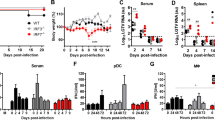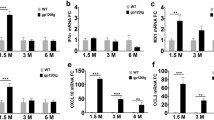Abstract
Borna disease virus (BDV) persistently infects neurons of the central nervous system of various hosts, including rats. Since type I IFN-mediated antiviral response efficiently blocks BDV replication in primary rat embryo fibroblasts, it has been speculated that BDV is not effectively sensed by the host innate immune system in the nervous system. To test this assumption, organotypical rat hippocampal slice cultures were infected with BDV for up to 4 weeks. This resulted in the secretion of IFN and the up-regulation of IFN-stimulated genes. Using the rat Mx protein as a specific marker for IFN-induced gene expression, astrocytes and microglial cells were found to be Mx positive, whereas neurons, the major cell type in which BDV is replicating, lacked detectable levels of Mx protein. In uninfected cultures, neurons also remained Mx negative even after treatment with high concentrations of IFN-α. This non-responsiveness correlated with a lack of detectable nuclear translocation of both pSTAT1 and pSTAT2 in these cells. Consistently, neuronal dissemination of BDV was not prevented by treatment with IFN-α. These data suggest that the poor innate immune response in rat neurons renders this cell type highly susceptible to BDV infection even in the presence of exogenous IFN-α. Intriguingly, in contrast to rat neurons, IFN-α treatment of mouse neurons resulted in the up-regulation of Mx proteins and block of BDV replication, indicating species-specific differences in the type I IFN response of neurons between mice and rats.






Similar content being viewed by others
References
Hornig M, Briese T, Lipkin WI (2003) Borna disease virus. J Neurovirol 9(2):259–273
Hornig M, Briese T, Licinio J, Khabbaz RF, Altshuler LL, Potkin SG, Schwemmle M, Siemetzki U, Mintz J, Honkavuori K, Kraemer HC, Egan MF, Whybrow PC, Bunney WE, Lipkin WI (2012) Absence of evidence for bornavirus infection in schizophrenia, bipolar disorder and major depressive disorder. Mol Psychiatry 17(5):486–493
Horie M, Honda T, Suzuki Y, Kobayashi Y, Daito T, Oshida T, Ikuta K, Jern P, Gojobori T, Coffin JM, Tomonaga K (2010) Endogenous non-retroviral RNA virus elements in mammalian genomes. Nature 463(7277):84–87
Mayer D, Fischer H, Schneider U, Heimrich B, Schwemmle M (2005) Borna disease virus replication in organotypic hippocampal slice cultures from rats results in selective damage of dentate granule cells. J Virol 79(18):11716–11723
Wu YJ, Schulz H, Lin CC, Saar K, Patone G, Fischer H, Hubner N, Heimrich B, Schwemmle M (2013) Borna disease virus-induced neuronal degeneration dependent on host genetic background and prevented by soluble factors. Proc Natl Acad Sci USA. doi:10.1073/pnas.1214939110
Bowie AG, Unterholzner L (2008) Viral evasion and subversion of pattern-recognition receptor signalling. Nat Rev Immunol 8(12):911–922
Haller O, Kochs G, Weber F (2007) Interferon, Mx, and viral countermeasures. Cytokine Growth Factor Rev 18(5–6):425–433. doi:10.1016/j.cytogfr.2007.06.001
Habjan M, Andersson I, Klingstrom J, Schumann M, Martin A, Zimmermann P, Wagner V, Pichlmair A, Schneider U, Muhlberger E, Mirazimi A, Weber F (2008) Processing of genome 5′ termini as a strategy of negative-strand RNA viruses to avoid RIG-I-dependent interferon induction. PLoS ONE 3(4):e2032
Martin A, Hoefs N, Tadewaldt J, Staeheli P, Schneider U (2011) Genomic RNAs of Borna disease virus are elongated on internal template motifs after realignment of the 3′ termini. Proc Natl Acad Sci USA 108(17):7206–7211
Matsumoto Y, Hayashi Y, Omori H, Honda T, Daito T, Horie M, Ikuta K, Fujino K, Nakamura S, Schneider U, Chase G, Yoshimori T, Schwemmle M, Tomonaga K (2011) Bornavirus closely associates and segregates with host chromosomes to ensure persistent intranuclear infection. Cell Host Microbe 11(5):492–503
Unterstab G, Ludwig S, Anton A, Planz O, Dauber B, Krappmann D, Heins G, Ehrhardt C, Wolff T (2005) Viral targeting of the interferon-{beta}-inducing Traf family member-associated NF-{kappa}B activator (TANK)-binding kinase-1. Proc Natl Acad Sci USA 102(38):13640–13645
Hallensleben W, Staeheli P (1999) Inhibition of Borna disease virus multiplication by interferon: cell line differences in susceptibility. Arch Virol 144(6):1209–1216
Staeheli P, Sentandreu M, Pagenstecher A, Hausmann J (2001) Alpha/beta interferon promotes transcription and inhibits replication of Borna disease virus in persistently infected cells. J Virol 75(17):8216–8223
Grimm D, Staeheli P, Hufbauer M, Koerner I, Martinez-Sobrido L, Solorzano A, Garcia-Sastre A, Haller O, Kochs G (2007) Replication fitness determines high virulence of influenza A virus in mice carrying functional Mx1 resistance gene. Proc Natl Acad Sci USA 104(16):6806–6811. doi:10.1073/pnas.0701849104
Schmid S, Mayer D, Schneider U, Schwemmle M (2007) Functional characterization of the major and minor phosphorylation sites of the P protein of Borna disease virus. J Virol 81(11):5497–5507
Hoffmann M, Wu YJ, Gerber M, Berger-Rentsch M, Heimrich B, Schwemmle M, Zimmer G (2011) Fusion-active glycoprotein G mediates the cytotoxicity of vesicular stomatitis virus M mutants lacking host shut-off activity. J Gen Virol 91(Pt 11):2782–2793
Horisberger MA, de Staritzky K (1987) A recombinant human interferon-alpha B/D hybrid with a broad host-range. J Gen Virol 68(Pt 3):945–948
Schneider U, Schwemmle M, Staeheli P (2005) Genome trimming: a unique strategy for replication control employed by Borna disease virus. Proc Natl Acad Sci USA 102(9):3441–3446
Schneider U, Naegele M, Staeheli P, Schwemmle M (2003) Active Borna disease virus polymerase complex requires a distinct nucleoprotein-to-phosphoprotein ratio but no viral X protein. J Virol 77(21):11781–11789
Kuri T, Habjan M, Penski N, Weber F (2010) Species-independent bioassay for sensitive quantification of antiviral type I interferons. Virol J 7:50
Carbone KM, Rubin SA, Sierra-Honigmann AM, Lederman HM (1993) Characterization of a glial cell line persistently infected with Borna disease virus (BDV): influence of neurotrophic factors on BDV protein and RNA expression. J Virol 67(3):1453–1460
Laemmli UK, Teaff N, D’Ambrosia J (1974) Maturation of the head of bacteriophage T4. III. DNA packaging into preformed heads. J Mol Biol 88(4):749–765
Stadler K, Bierwirth C, Stoenica L, Battefeld A, Reetz O, Mix E, Schuchmann S, Velmans T, Rosenberger K, Brauer AU, Lehnardt S, Nitsch R, Budt M, Wolff T, Kole MH, Strauss U (2012) Elevation in type I interferons inhibits HCN1 and slows cortical neuronal oscillations. Cereb Cortex. doi:10.1093/cercor/bhs305
Rubinstein S, Familletti PC, Pestka S (1981) Convenient assay for interferons. J Virol 37(2):755–758
Ackermann A, Kugel D, Schneider U, Staeheli P (2007) Enhanced polymerase activity confers replication competence of Borna disease virus in mice. J Gen Virol 88(Pt 11):3130–3132. doi:10.1099/vir.0.83170-0
Butchi NB, Du M, Peterson KE (2010) Interactions between TLR7 and TLR9 agonists and receptors regulate innate immune responses by astrocytes and microglia. Glia 58(6):650–664
Paladino P, Cummings DT, Noyce RS, Mossman KL (2006) The IFN-independent response to virus particle entry provides a first line of antiviral defense that is independent of TLRs and retinoic acid-inducible gene I. J Immunol 177(11):8008–8016
Holm CK, Jensen SB, Jakobsen MR, Cheshenko N, Horan KA, Moeller HB, Gonzalez-Dosal R, Rasmussen SB, Christensen MH, Yarovinsky TO, Rixon FJ, Herold BC, Fitzgerald KA, Paludan SR (2012) Virus-cell fusion as a trigger of innate immunity dependent on the adaptor STING. Nat Immunol 13(8):737–743
Delhaye S, Paul S, Blakqori G, Minet M, Weber F, Staeheli P, Michiels T (2006) Neurons produce type I interferon during viral encephalitis. Proc Natl Acad Sci USA 103(20):7835–7840
Kallfass C, Ackerman A, Lienenklaus S, Weiss S, Heimrich B, Staeheli P (2012) Visualizing production of beta interferon by astrocytes and microglia in brain of La Crosse virus-infected mice. J Virol 86(20):11223–11230. doi:10.1128/JVI.01093-12
Richt JA, Stitz L (1992) Borna disease virus-infected astrocytes function in vitro as antigen-presenting and target cells for virus-specific CD4-bearing lymphocytes. Arch Virol 124(1–2):95–109
Ovanesov MV, Ayhan Y, Wolbert C, Moldovan K, Sauder C, Pletnikov MV (2008) Astrocytes play a key role in activation of microglia by persistent Borna disease virus infection. J Neuroinflammation 5:50
Gonzalez-Dunia D, Volmer R, Mayer D, Schwemmle M (2005) Borna disease virus interference with neuronal plasticity. Virus Res 111(2):224–234
Yin J, Gardner CL, Burke CW, Ryman KD, Klimstra WB (2009) Similarities and differences in antagonism of neuron alpha/beta interferon responses by Venezuelan equine encephalitis and Sindbis alphaviruses. J Virol 83(19):10036–10047
Acknowledgments
We thank Thomas Michiels, Friedemann Weber, Peter Staeheli, and Georg Kochs for critical reading of the manuscript and Simone Zenker for excellent technical assistance. The study was supported by the Deutsche Forschungsgemeinschaft (DFG) to MS (SCHW 632), BH (He 1520), and in part by the Excellence Initiative of the German Federal and State Governments (GSC-4, Spemann Graduate School).
Author information
Authors and Affiliations
Corresponding authors
Electronic supplementary material
Below is the link to the electronic supplementary material.
18_2013_1402_MOESM1_ESM.tif
Fig. S1 Rat IFN-α/β treatment results in the expression of Mx1 in microglial cells. SD hippocampal slice cultures were either BDV-infected (a) or treated with rat IFN-α/β (103 U/ml) (b). Medium was changed three times per week over 3 weeks. The tissue cultures were fixed on day 21 and stained for the presence of Mx1 (α-Mx1), microglial cells (α-Iba-1) or neurons (α-NeuN). Cell nuclei were visualized with ToPro3. Scale bars, 10 µm (TIFF 4059 kb)
18_2013_1402_MOESM2_ESM.tif
Fig. S2 BDV replication in neurons is not abrogated by treatment with rat type I IFN. (a) BDV-infected hippocampal slice cultures from SD rats were either treated or untreated with rat IFN-α/β (103 U/ml) after 3 days of virus infection. The medium was changed three times per week over 4 weeks. At the indicated time point post-infection, the cell extract was prepared from a pool of at least four cultures and analyzed by Western blotting for the presence of the indicated proteins. (b) Rat hippocampal slice cultures from SD rats were either pretreated with 103 U/ml of rat IFN-α/β for 6 h (IFN pretreated) or left untreated (untreated) and subsequently infected with BDV (1,000 FFU). Medium containing 1,000 U of rat IFN-α/β was changed three times per week in pretreated cultures, whereas no additional IFN was added to the untreated cultures. 21 days post-infection (dpi) viral dissemination was determined by immunofluorescence using BDV-P-specific antibodies. Cell nucleus was visualized by TpPro-3. Scale bars, 10 µm (TIFF 6830 kb)
Rights and permissions
About this article
Cite this article
Lin, CC., Wu, YJ., Heimrich, B. et al. Absence of a robust innate immune response in rat neurons facilitates persistent infection of Borna disease virus in neuronal tissue. Cell. Mol. Life Sci. 70, 4399–4410 (2013). https://doi.org/10.1007/s00018-013-1402-5
Received:
Revised:
Accepted:
Published:
Issue Date:
DOI: https://doi.org/10.1007/s00018-013-1402-5




